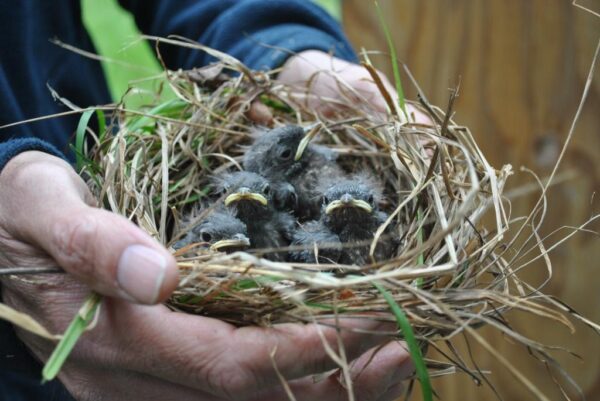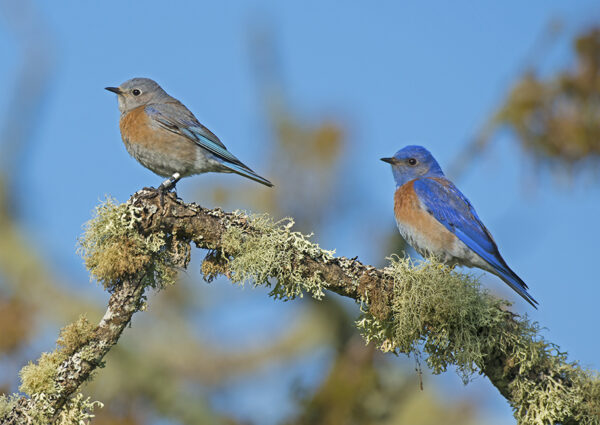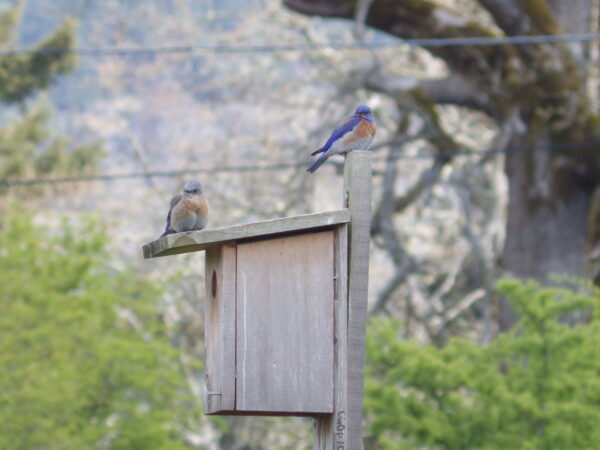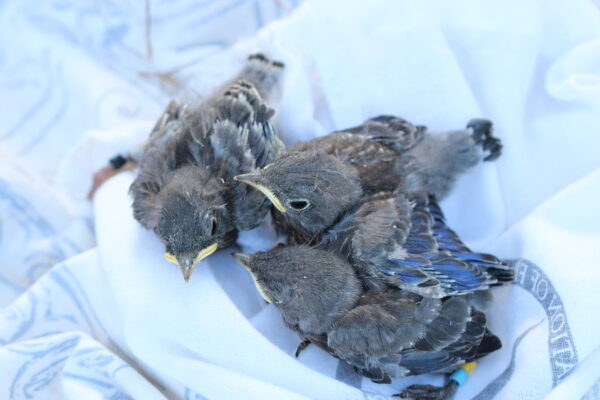Bring Back the Bluebirds (2012–2016)

Bluebird nestlings arrive in their new home, the Cowichan Valley (photo by Trudy Chatwin)
The Bring Back the Bluebirds program was led by the Garry Oak Ecosystem Recovery Team from 2012 through 2016. Since 2017, this program has been led by the British Columbia Conservation Foundation in partnership with the Cowichan Valley Naturalists. Visit their website to learn about the current activities.
Rebuilding a Lost Western Bluebird Population
As recently as 60 years ago, Western Bluebirds (Sialia mexicana) were common in Garry Oak meadows and savannahs throughout Vancouver Island, the southern Gulf Islands, and nearby areas in Washington such as the San Juan Islands. By 1995, Western Bluebirds were no longer breeding in southwestern BC and were rarely seen, and this population was placed on the Red List and considered extirpated (locally extinct) in BC.
Their rapid decline both here and in areas of Washington and Oregon was likely due to a combination of factors: loss of Garry Oak habitat, removal of standing dead trees that provided cavities for nesting, and competition for remaining nest holes with exotic bird species such as European Starlings and English House Sparrows.
The goal of the Bring Back the Bluebirds program was to re-establish a breeding population of Western Bluebirds on southeastern Vancouver Island and the southern Gulf Islands. As a result of the program, Western Bluebirds were once again breeding on Vancouver Island, after being considered locally extinct for almost 20 years!

A Western Bluebird pair rests in a Garry Oak tree in Duncan, 2015 (photo by Bill Pennell)

In 2013, a juvenile female who hatched in Maple Bay in 2012 returned to the Cowichan Valley, found a mate, laid this clutch of 7 eggs, and successfully fledged all 6 nestlings that hatched.
Our Species Recovery Approach
Bring Back the Bluebirds was part of an international effort to restore bluebirds to the Salish Sea area. The project brought together a suite of project partners, landowners, and citizen scientists to restore Western Bluebirds to our area.We used a two-pronged approach to restoring a population of this native songbird.

Bluebirds will return to a successful breeding territoriy. This pair returned in 2013 to this nestbox, which they had used in 2012.
Bluebirds are cavity nesters, meaning they rely on safe holes in large, old trees to build their nests. We worked with private landowners throughout the area to mount and monitor nestboxes in suitable habitat.

Translocated Bluebird nestlings in May 2016
We also captured Western Bluebirds from a healthy population in Washington, and released them in the Cowichan Valley, a conservation technique called translocation. Our project was focused in the Cowichan Valley, near Quamichan and Somenos lakes, where we released bluebirds starting in 2012. We continued translocations of up to 10 pairs of bluebirds each year until 2016, with a goal of releasing a total of 90 adult bluebirds over the course of this 5-year project. Each spring, in addition to the bluebirds we released, we observed adult and juvenile bluebirds returning to the Cowichan Valley. They were successfully establishing breeding territories in suitable habitat, finding mates, and raising broods of their own.
For More Information
- Visit the Cowichan Bring Back the Bluebirds website, the current leaders of this program.
- Learn about the San Juan Islands Western Bluebird Reintroduction Project, the successful five-year project that provided the model for our program.
- Read the Western Bluebird entry in our species at risk field manual
- Visit the North American Bluebird Society
This episode of EcoPeek stared our former project technician, Julia Daly, our partner Gary Slater from Ecostudies Institute, and of course one of our bluebird families! Host Liz Bailey (also our 2013 summer student) explained the importance of Garry Oak ecosystems, why bluebirds disappeared, and how we’re working to bring them back.
In 2013, Shaw TV spent a morning feeding and monitoring Western Bluebirds in the Cowichan Valley with Bluebird Project Technician, Julia Daly, and had a chance to discuss the project with one of the landowners who hosts aviaries and growing bluebird families.
Project Partners
Bring Back the Bluebirds was led by the Garry Oak Ecosystems Recovery Team from 2012 to 2016, with partners Ecostudies Institute, Province of BC, Nature Conservancy of Canada, and the Cowichan Valley Naturalists.
Additional partners included: American Bird Conservancy, Joint Base Lewis-McChord (Jim Lynch), Point Defiance Zoo and Aquarium (Dr. Karen Wolf), Rocky Point Bird Observatory, Salt Spring Island Conservancy, San Juan Preservation Trust, and Victoria Natural History Society. Also Environment Canada (Canadian Wildlife Service), Canadian Food Inspection Agency, Washington Department of Fish and Wildlife, and US Fish and Wildlife Service.
Other project funders for 2015 included: The Baillie Fund of Bird Studies Canada, Canada Summer Jobs, Habitat Conservation Trust Foundation, The McLean Foundation, MEC, North American Bluebird Society, Public Conservation Assistance Fund, Sitka Foundation, TD Friends of the Environment, Victoria Natural History Society, Science Horizons Youth Internship Program, and private donors.